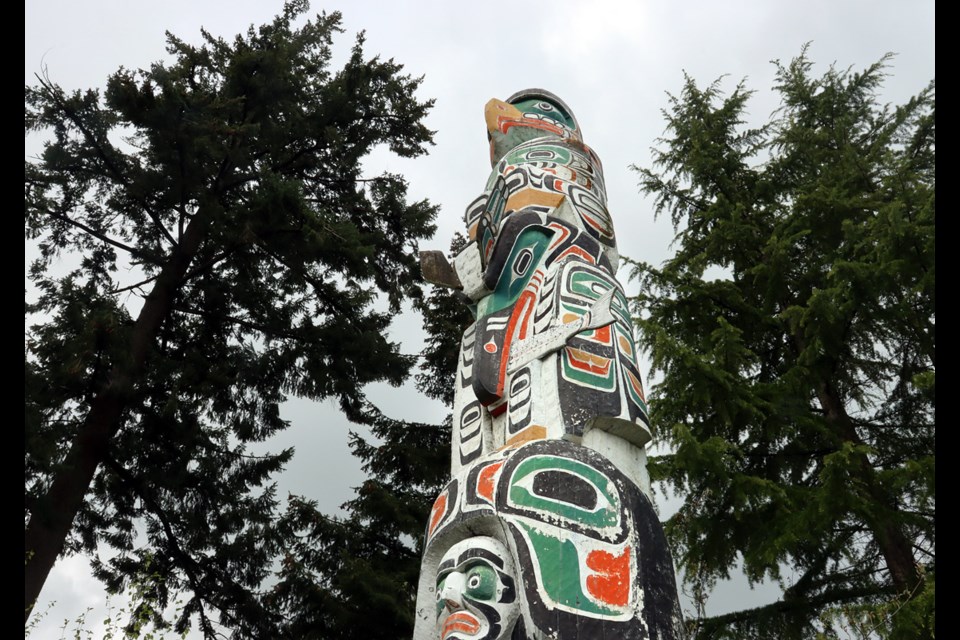An impressive totem pole carved by First Nations artists nearly 60 years ago is starting to show its age.
The brightly-coloured pole soars 26-feet in height and is located next to Dogwood Pavillon near Poirier Street in Coquitlam. Featuring sharply-detailed images of a thunderbird, an eagle eating a salmon and human figures, the pole was carved to celebrate Canada’s 100th birthday in 1967.
But the paint is peeling and the thunderbird is missing its wings, giving rise to questions about the future of the cultural icon tucked in next to the city’s rose garden.
What happens next to the beautiful totem is up to the city of Coquitlam, an indigenous consultant and the family of the carvers, according to cultural manager Karen Basi.
She told the Tri-City News in an email that the process to develop a plan for the pole’s final destination has been held up by COVID-19 but will “respect Indigenous traditions and celebrate Indigenous cultures.”
The wings are currently being stored, she said, and assessments have determined that the totem pole carved by Kwakwaka’wakw First Nation men from Vancouver Island “has deteriorated beyond reasonable repair.”
The pole will be decommissioned and an offer made to return it to the carver’s family, Basi further stated.
TOTEM POLES REPRESENT FAMILIES' HERITAGE, 'BLOOD, SWEAT AND TOIL'
That idea of returning the pole to the family sits well with SFU professor and archaeologist Eldon Yellowhorn who said the carvers — Lloyd Wadhams Senior (Head Carver), John Edward (Ted) Neel Junior and Robert (Bob) Whonnock — are from the Kwakiutl Nation. Returning the pole to the family would be a sign of respect to the carvers and a recognition of their artistry.
The pole represents “their blood, sweat and toil,” he said, noting that the images are likely representative of the chief and the clan.
“You’re looking at their mythical ancestors that are represented on the totem,” Yellowhorn said.
While in the past, the poles were built as “memory aids” to tell the family’s story, they were allowed to fall down and decompose in the forest.
Now, instead of letting the pole disintegrate, repatriating the pole is becoming more common, said Yellowhorn.
He cited as an example the return of a pole, called the Raven, that had been taken from Haida Gwaii over 100 years ago and sold to the Grand Trunk Railroad as a tourism exhibit. When the base of the poll began to deteriorate, Parks Canada had the pole returned in 2011 and a new pole was carved — called the Two Brothers Totem Pole — and raised in Jasper.
TOTEM POLES HAVE INTRINSIC VALUE AS THEY REPRESENT ARTISTIC ACHIEVEMENTS
The original pole is protected and commemorates the artists who carved it. Similar recognition could be given to Coquitlam’s Centennial pole if it was returned, Yellowhorn said.
“Now because they represent artistic achievements, they’ve developed intrinsic value even if the carvers are no longer with us.”
An archeologist, Yellowhorn is Piikani and has family and cultural ties to the Peigan Indian Reserve inn Southern Alberta. He was appointed to faculty at Simon Fraser University in 2002 and established the Department of Indigenous Studies in 2012. He teaches courses dedicated to chronicling the experience of Aboriginal people across Canada.
According to Yellowhorn, Coast Salish people, such as the Kwikwetlem First Nation, who live and have land claims in the Tri-Cities area, did not carve totem poles. So to create the Centennial pole, Coquitlam had to engage carvers from Vancouver Island.
A long-time figure in Coquitlam city hall thinks the totem pole could be restored and used for educational purposes.
'A GIFT' — POLE CARVED TO CELEBRATE CANADA's 100th BIRTHDAY
According to Don Cunnings, a retired Coquitlam parks and recreation manager, the pole was carved near the site where it stands and the pole project initiated by The Columbian newspaper to mark Canada's 100th anniversary was a big deal for residents at the time.
Many contributed donations for the pole’s carving, and a large crowd, including members of the Kwikwetlem First Nations, attended the pole raising, which Cunnings characterized as a celebration of cultures.
He agrees with Yellowhorn that asking the family what should be done with the pole, and possibly repatriating it, would be a fitting way to honour the carvers.
However, he would also like to see the pole restored and retained so it can be used by local teachers to educate their students about First Nations culture and history.
“It’s kind of a gift,” Cunnings said.
Coquitlam has been considering the future of the Centennial totem pole for a few years. An original cost estimate to restore the pole was $30,000.




